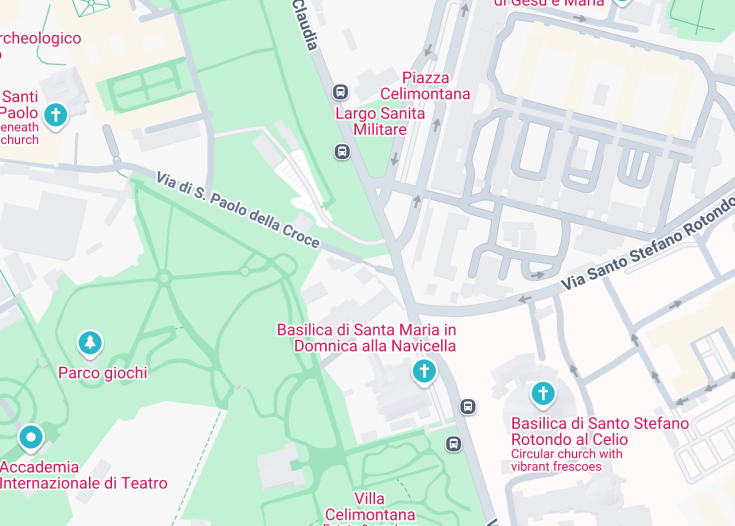The Arco di Dolabella, located in Rome, is a monumental arch that once served as the Porta Caelimontana on the ancient Servian Wall. This architectural wonder showcases a blend of historical significance and remarkable engineering, constructed in 10 A.D. under the consuls Dolabella and Silano, making it a notable landmark in the city’s rich tapestry of history.
Visitors should take a moment to admire the intricate details of the arch while reflecting on its storied past. Be sure to capture photographs from various angles to appreciate its grandeur fully against the backdrop of the surrounding Roman architecture.
For a more enriching experience, consider joining a guided tour that delves into the history of the Arco di Dolabella. This will provide deeper insights into its significance in ancient Roman society and enhance your understanding of the broader context of Roman architecture.
Explore the Architectural Grandeur of Arco di Dolabella in Rome, Italy
The Arco di Dolabella, also known as Porta Caelimontana, is a remarkable ancient structure that once served as a gateway through the Servian Walls of Rome. This well-preserved travertine arch features a grand classical façade adorned with decorative elements characteristic of Roman architecture. Originally built in 10 A.D. under the direction of two Roman consuls, Publio Cornelio Dolabella and Gaio Giunio Silano, it exemplifies the engineering prowess of the era. The arch underwent significant restoration under Emperor Caracalla in 211 A.D., integrating it with the nearby Neronian aqueduct, thus showcasing the intersection of architecture and utility in Roman design.
The overall structure is a testament to the meticulous craftsmanship of ancient artisans, with remnants of the earlier tufo blocks visible, adding to the arch’s historical significance. Visitors can appreciate the inscriptions that commemorate the consuls responsible for its construction, which provide insights into the social and political context of early imperial Rome. The Arco di Dolabella connects to essential city routes, making it a pivotal point in the urban landscape of Rome.
History
4th Century B.C. – Early Construction
The origins of the Arco di Dolabella can be traced back to the early construction of the Servian Walls in the 4th century B.C. This period marked the initial fortification efforts of the city, incorporating vital access points such as the Porta Caelimontana. Although its exact antiquity remains debated, evidence suggests that the arch served as a crucial entryway during the Roman Republic.
10 A.D. – Restoration and Reconstruction
In 10 A.D., the structure was reconstructed under the consular authority of Publio Cornelio Dolabella and Gaio Giunio Silano. This transformation replaced the earlier structure with an enduring travertine arch, reflecting advancements in Roman construction techniques. The incorporation of detailed inscriptions further illustrates the significance of this restoration, indicating the continuous evolution of the arch’s importance within the city.
211 A.D. – Integration with Aqueduct
The arch experienced additional modifications during the reign of Emperor Caracalla in 211 A.D. This phase involved reinforcing the arch to support the adjacent Neronian aqueduct. The adaptation of the structure for utilitarian purposes underscores the versatile role of Roman architecture in urban development, merging aesthetic and functional elements in the monumental narrative of Rome.
Activities and Attractions Around Arco di Dolabella
Visitors to the Arco di Dolabella can immerse themselves in the vibrant history of Rome while exploring the surrounding area. The arch is conveniently located near several important landmarks, including the Basilica of San Giovanni e Paolo and the impressive ruins of the Domus Faustae. Walking tours are available, leading guests through the striking architecture of the Celio neighborhood, emphasizing the juxtaposition of ancient structures against modernity. Photographic opportunities abound, particularly with the architectural beauty of the arch as a backdrop.
Connection to San Giovanni del Matha
The Arco di Dolabella is linked to the life of Saint John of Matha, who is believed to have lived in a small chamber above the arch during the early 13th century. This connection offers an intriguing glimpse into the medieval history of the site, giving visitors an added layer of cultural significance. The juxtaposition of religious heritage with ancient architecture allows for a rich exploration of the deep-rooted traditions that have shaped the identity of Rome over centuries.
General informations
Location
The Porta Caelimontana, also known as the Arco di Dolabella, is located in the historic heart of Rome, near the Celio hill. It is easily accessible from various landmarks, including the Basilica di San Giovanni in Laterano and the nearby metro stations.
Address:
Via di S. Paolo della Croce, 00184 Roma RM, ItalyVisiting Information
The Arco di Dolabella is open to the public and can be visited at any time, as it is part of the open urban landscape of Rome. For an optimal experience, visiting early in the morning or late afternoon is recommended, when the lighting offers a beautiful view of this ancient structure.
How to reach the destination
Car
The Arco di Dolabella can be easily accessed by car. There are various parking options available nearby, though some may charge a fee.
| Route | Distance | Travel time |
|---|---|---|
| From Fiumicino Airport | 30 miles (48 km) | 45 minutes |
| From Rome City Center | 2 miles (3 km) | 15 minutes |
| From Vatican City | 3 miles (5 km) | 20 minutes |
Public Transport
The Arco di Dolabella is also reachable by public transport, with several bus lines and metro stations located in close proximity.
| Route | Distance | Travel time |
|---|---|---|
| From Termini Station | 1.5 miles (2.4 km) | 10 minutes by bus |
| From Colosseum Metro Station | 0.6 miles (1 km) | 8 minutes walking |
Accessibility and Limitations
The Arco di Dolabella is generally accessible, though the surrounding area may have uneven surfaces typical of historic structures.
Accessibility
Limitations
- Limited seating areas nearby.
- Lack of informational signage in multiple languages.
Notes to visitors
- Be cautious of nearby traffic while enjoying the area.
- Consider visiting during off-peak hours for a quieter experience.
Common questions
What are the best ways to experience the Arco di Dolabella?
The Arco di Dolabella, located in the heart of Rome, offers visitors a unique glimpse into ancient architecture. To truly appreciate this remarkable structure, consider the following experiences:
- Join a guided tour: Professional guides can provide insights into the history and significance of the arch, allowing for a deeper understanding of its context within the ancient city.
- Photograph the arch: The Arco di Dolabella presents an excellent opportunity for photography, especially during the golden hours of sunrise and sunset when the lighting enhances its grandeur.
- Explore the surrounding area: The arch is situated near other historical sites like the Basilica of San Giovanni in Laterano and the Colosseum, allowing visitors to explore multiple attractions in one visit.
- Relax at nearby cafés: After admiring the arch, take a moment to relax at one of the local cafés or eateries nearby. You can savor authentic Italian pastries and espresso, soaking in the atmosphere.
- Attend events: Keep an eye out for local cultural events or exhibitions that might take place near the Arco di Dolabella, providing a chance to experience the area in a vibrant, livelier context.
By engaging in these activities, you can enhance your visit to the Arco di Dolabella and make lasting memories of your time in Rome.
Are there any nearby attractions to visit while at the Arco di Dolabella?
Yes, the Arco di Dolabella is surrounded by several notable attractions that enrich your visit. Here’s a list of nearby places you might consider exploring:
- Basilica of San Giovanni in Laterano: Just a short walk away, this is one of the four papal major basilicas and is rich in history and stunning architecture.
- Colosseum: About a 20-minute walk from the arch, this iconic symbol of Rome offers an unforgettable glimpse into ancient Roman entertainment.
- Roman Forum: Nearby, this area was the center of Roman public life, featuring ruins that provide insights into the civilization’s political and social structures.
- Basilica di San Clemente: This church, located nearby, is famous for its layers of history, with structures from different eras stacked on top of each other.
- Park of Celio: A nearby green space perfect for a leisurely stroll or a picnic, offering a peaceful retreat from the bustling streets of Rome.
Exploring these nearby attractions, in addition to the Arco di Dolabella, will provide a well-rounded experience of Rome’s history and culture.
What is the best time of year to visit the Arco di Dolabella?
The best time to visit the Arco di Dolabella in Rome can vary based on your preferences for weather, crowd levels, and local events. Here are key considerations:
- Spring (March to May): This is a prime time for visiting. The mild weather and blooming flora create a beautiful backdrop, and the tourist crowds are manageable compared to the summer months.
- Fall (September to November): Another excellent season to visit, the temperatures are comfortable, and the fall colors add a unique charm to the area. Many cultural events and festivals also take place during this time.
- Summer (June to August): While summer is popular for tourists, be prepared for hot weather and larger crowds. If visiting in summer, aim for early morning or late afternoon visits to avoid the heat and congestion.
- Winter (December to February): The winter months can be chilly, but visiting in the off-season can mean fewer tourists. Possible festive decorations and events during the Christmas season can add to the experience.
Ultimately, the best time depends on your personal preferences, but spring and fall are typically favored for a pleasant atmosphere and enjoyable exploration of the Arco di Dolabella and its surroundings.
What can tourists learn from visiting the Arco di Dolabella?
Visiting the Arco di Dolabella provides tourists with a valuable opportunity to learn about ancient Roman architecture, history, and culture. Here are several key aspects you can discover:
- Architectural Significance: The arch showcases the engineering prowess of ancient Romans, featuring intricate designs and durable materials that have stood the test of time.
- Historical Context: The arch was initially part of the Servian walls and was refurbished in various periods, giving insight into the evolution of city defenses and structures over centuries.
- Cultural Insights: Engaging with the local guides can reveal the stories behind the arch, including its connection to notable figures like Dolabella and its use in Roman rituals and celebrations.
- Influence on Modern Architecture: The design elements of the Arco di Dolabella influenced future architectural styles, which can be fascinating to explore for those interested in design and history.
- Religious Heritage: Given its proximity to religious sites, visitors can reflect on the interplay between ancient Roman pagan beliefs and later Christian influences in architectural designs.
By learning from these aspects during your visit, you’ll gain a deeper appreciation for the Arco di Dolabella and its place in the rich mosaic of Rome’s history.
Is there any local cuisine to try near the Arco di Dolabella?
Absolutely! The area surrounding the Arco di Dolabella is rich with culinary delights that reflect Rome’s vibrant food culture. Here are some local dishes and dining recommendations:
- Carbonara: A classic Roman pasta dish made with egg, cheese, pancetta, and pepper. Several trattorias in the area serve authentic versions of this beloved dish.
- Artichokes (Carciofi): Roman-style artichokes are a seasonal delicacy. Look for dishes like “Carciofi alla Romana” or “Carciofi fritti” at nearby restaurants.
- Roman Pizza: Also known as pizza al taglio, it’s a must-try. You can find slices at bakeries and pizzerias around the arch, often sold by weight.
- Supplì: These delicious rice balls filled with mozzarella and fried until golden brown make for a perfect snack or appetizer to enjoy nearby.
- Gelato: No visit to Rome is complete without sampling some gelato. Numerous gelaterias near the Arco di Dolabella offer an array of flavors to indulge in.
Exploring the local cuisine while visiting the Arco di Dolabella not only satiates your appetite but enhances your overall Roman experience, allowing you to savor the flavors of Italy.

Is the Arco di Dolabella in Rome worth visiting?
The Arco di Dolabella, also known as the former Porta Caelimontana, is a fascinating site nestled in the historic area of Rome. As a remnant of the ancient Servian Walls, it offers visitors a glimpse into the architectural prowess of early Roman civilization. Standing since the early IV century B.C., this arch was later restored in 10 A.D. and serves as a testament to Rome’s rich history.
Furthermore, its location near significant landmarks like the Basilica of San Giovanni in Laterano adds to its allure, making it a perfect spot for history enthusiasts and casual tourists alike. Adding to this, the surrounding area is bustling with cafes and shops, allowing visitors to immerse themselves in the local culture. Overall, a visit to the Arco di Dolabella is certainly rewarding for those seeking to explore Rome’s illustrious past!









